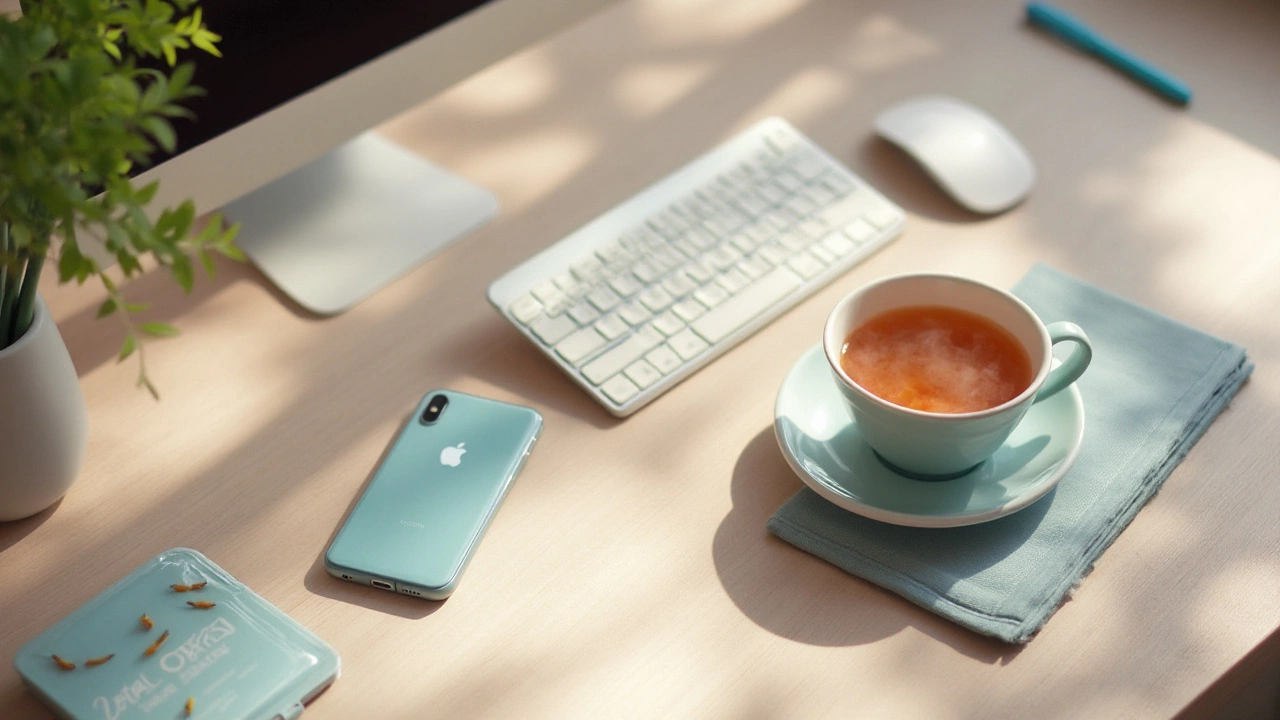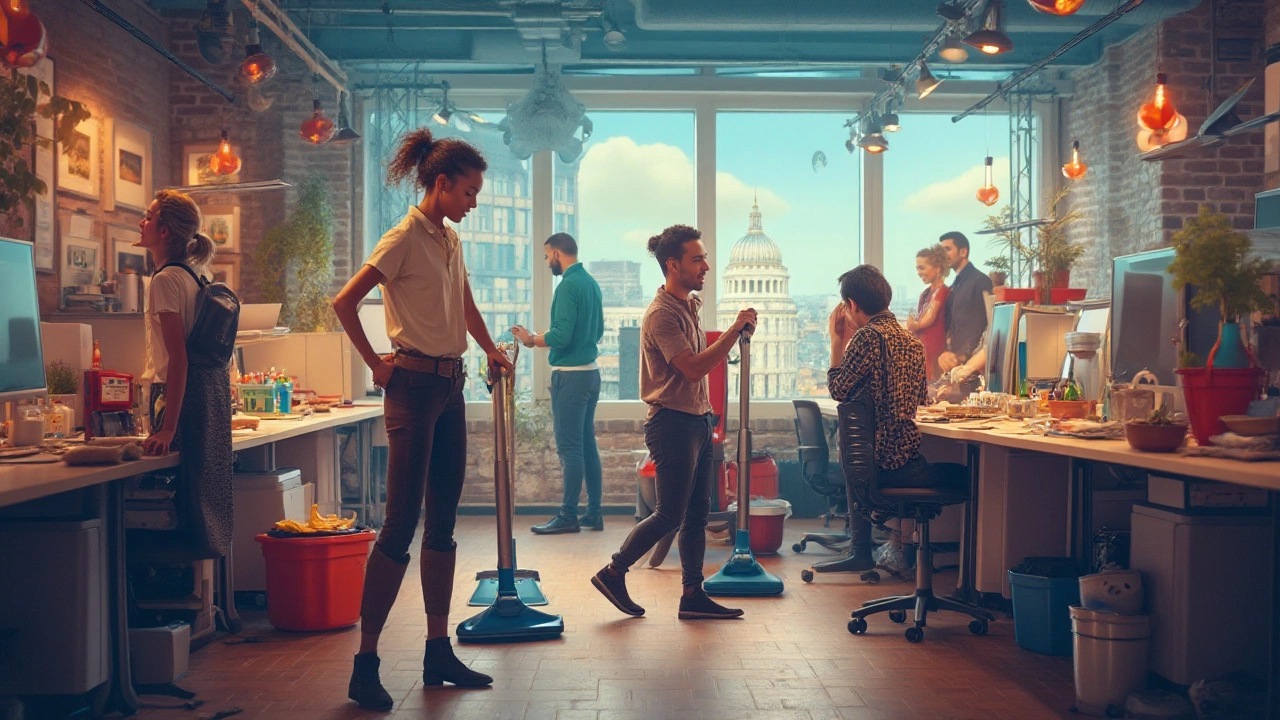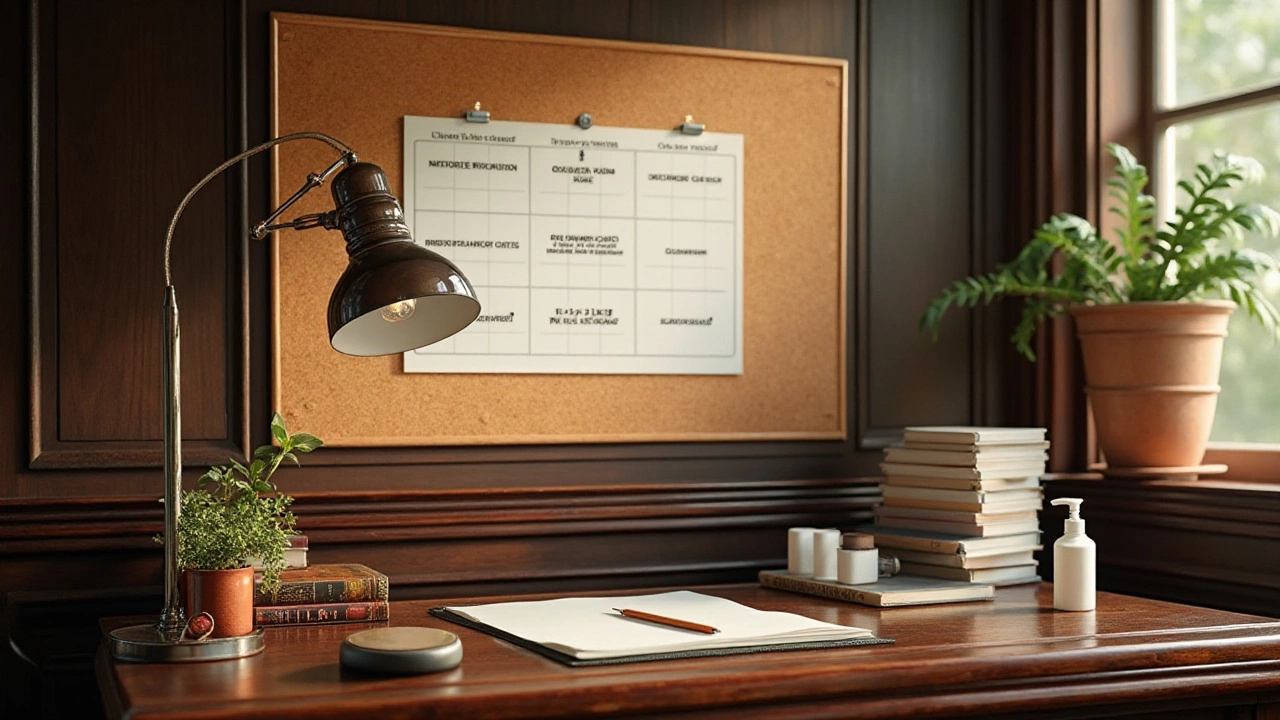Keeping an office clean is more than just a chore—it's a way to create a space that boosts productivity and comfort. An organized workspace can make a massive difference in how you feel about your work environment, reducing stress and promoting efficiency.
But how do you ensure your office is sparkling and professional-looking without spending your entire day cleaning? In this guide, we'll explore simple yet effective strategies used by professional cleaners to keep workplaces in top shape.
Whether you're setting up your cleaning schedule or wondering which supplies are worth investing in, this article has got you covered. Let's embark on this cleaning adventure to transform your office into a pristine powerhouse.
- Setting Up a Cleaning Schedule
- Essential Cleaning Tools and Supplies
- Desk Organization Techniques
- Technology Hygiene Best Practices
- Maintaining Office Cleanliness
Setting Up a Cleaning Schedule
One of the key elements to maintain a consistently clean office is having a well-organized cleaning schedule. This not only helps keep everything tidy but also ensures you can focus on your work without the distraction of clutter. Setting a schedule begins with understanding the specific needs of your office; daily tasks could include emptying waste bins, vacuuming, and wiping down surfaces, while weekly chores might involve more detailed cleaning of areas like windows or kitchens. Studies suggest that regular maintenance can enhance work efficiency by up to 20% because there's simply less mess getting in the way.
Start by listing all the tasks that need to be done and then categorize them based on how often they should be performed. Daily, weekly, and monthly categories are common, but every office is different. High-traffic areas may require more frequent attention. Having a list will not only help ensure nothing is overlooked but also serve as a reminder of the great feeling of checking off a completed task. According to a survey by ISSA, a global cleaning industry association, 88% of office workers stated that a clean office boosts their productivity.
"Cleanliness and order are not matters of instinct; they are matters of education, and like most great things, you must cultivate a taste for them." - Benjamin Disraeli
Implementing this schedule can involve assigning specific tasks to different individuals or groups, especially if the office is large. Rotating cleaning duties can ensure that everyone takes part in maintaining their workspace. Offices without in-house cleaners might set up a rota system among employees, allocating tasks in a fair manner. This not only distributes the load but also fosters a sense of shared responsibility.
Looking at a more detailed approach, efficiency can be enhanced by subliminal segmentation. This refers to breaking down tasks into smaller, more manageable units which are less daunting and easier to tackle within limited time slots, thereby making your cleaning process less disruptive to your day. For example, instead of planning two hours of extensive cleaning on a Friday afternoon, you could allocate 15 minutes every day to tackle a specific area.
Consider using a simple table to visualize this schedule, which can be shared among team members:
| Task | Frequency | Assigned To |
|---|---|---|
| Empty Bins | Daily | Team A |
| Vacuum Carpets | Weekly | Team B |
| Clean Windows | Monthly | Team C |
This method helps in planning and keeping your workspace tidying efficient. Such strategies ensure that the professional cleaning of your office becomes second nature and seamlessly integrates into your daily workflow, maintaining an inviting and productive environment.
Essential Cleaning Tools and Supplies
Having the right tools and supplies is crucial when it comes to achieving a truly pristine office space. The quality and type of items you use can dramatically affect both the efficiency with which you clean and the results themselves. Start with some high-quality microfiber cloths; they're a professional cleaning staple due to their ability to pick up dust and bacteria without leaving a trail of lint. Unlike regular cloths, microfiber can be used wet or dry, adding versatility to your cleanup routine. Supplement these with a reliable multi-surface cleaning spray. Opt for one that's eco-friendly if possible, as harsh chemicals can contribute to indoor air pollution.
Beyond the basics, a sturdy vacuum cleaner is a must-have. For optimal workspace tidying, select one with various attachments to reach nooks and crannies in your office where dust and crumbs often gather. Regular vacuums might not cut it on hardwood or other types of hard floors, so consider a vacuum designed for multi-floor surfaces. Some professionals also advocate for robot vacuum cleaners, which can autonomously handle daily routine sweeping, particularly effective in open-plan offices.
"A clean office isn't just about appearance; it contributes significantly to mental clarity," says Janet Griffiths, a veteran cleaning consultant with over two decades of experience in the field.
A set of quality trash bins placed conveniently throughout the office helps in maintaining consistent cleanliness. Office cleaning can sometimes feel overwhelming, especially in shared spaces, but organizing disposal systems can simplify this process. Opt for bins with separate sections for general waste and recycling. Now, if you want to take it a step further, consider installing an air purifier. Not only does it help in cleaning the air of common pollutants, but it also tackles office odors which improves the overall atmosphere.
Let's not forget specialized tools like screen wipes for your monitors and keyboards. These tools, which are often neglected, are vital in the chapter on technology hygiene. Screens attract fingerprints, while keyboards can harbor crumbs and bacteria. Choose wipes that are gentle but effective, keeping your tech in great shape. Consider anti-static sprays that help repel dust for longer-lasting results. Now, all these supplies might seem cumbersome in handling, but by organizing them neatly in a dedicated storage caddy or cart, you can move seamlessly from one room to the next without having to go back and forth.
Here's a practical tip: Label your supplies clearly and use transparent containers. This ensures that everyone in the office knows where things are, reducing downtime and enhancing productivity. Many professional services recommend adopting this practice for efficient workspace tidying.
| Cleaning Tool | Purpose |
|---|---|
| Microfiber Cloth | Dust and bacteria removal |
| Multi-Surface Spray | Cleaning various surfaces |
| Vacuum Cleaner | Efficient floor cleaning |
| Screen Wipes | Cleaning electronic devices |

Desk Organization Techniques
Mastering the art of desk organization is not just about aesthetics; it's about creating a space where efficiency meets serenity. A well-organized desk not only helps in accelerating your workflow but also reduces stress, which can be pivotal in boosting your productivity. Let's dig into some effective techniques that can transform your workspace into a haven of order and calm.
One of the first steps in organizing your desk is decluttering. It's not uncommon to accumulate items that serve little to no purpose. Begin by sorting through what’s on your desk, categorizing each item as either necessary or redundant. Essentials are those you use daily or weekly, like your computer, notebook, or favorite pen. Consider placing these items within easy reach, optimizing your movement when working. For items you rarely use, a drawer or shelf might be more appropriate.
This leads us to an incredibly useful technique: the 'one touch' rule. The idea here is to handle each piece of paper just once. This means either filing it away, tossing it out, or taking immediate action. According to Gretchen Rubin, author of several bestselling books on habits and happiness, "Outer order contributes to inner calm," which highlights the profound impact physical organization can have on mental clarity through even simple practices like these.
For those struggling to maintain an organized desk, consider implementing a system of trays or organizers. These small but mighty tools can help segment your workspace into zones dedicated to specific tasks. For instance, keep supplies like paper, staplers, and hole punches in a designated area. Similarly, allocate a spot for personal items. When everything has a place, clutter becomes less of a beast to tackle.
Another often overlooked technique is the power of digitization. With today's technology, much of your physical clutter can be converted into digital form. Scanning documents to keep them as PDFs not only saves space but also offers easy access and sharing capabilities. This is especially true for papers like receipts, meeting notes, and other documentation that tend to pile up. By reducing physical paper, you clear more space for practical use, ensuring a clutter-free, functional desk.
Let's not forget the impact that a touch of personalization can have on your space. Incorporating elements that reflect your personality, such as a photo, a small plant, or an inspiring quote, can not only make your workspace more inviting but also provide a small sense of comfort and familiarity. These small tokens can make the starkness of a highly functional desk feel more homey and welcoming.
When working on organizing your desk, it's vital to remember that this is an ongoing process. Regular maintenance is key to preventing the resurgence of clutter. Set aside a few minutes at the end of each day to put everything back where it belongs. Designate a timeframe weekly or bi-weekly to evaluate and adjust your setup as necessary. This efficient maintenance schedule will keep your workspace in tip-top shape without overwhelming efforts.
"If a cluttered desk is a sign of a cluttered mind, then what are we to think of an empty desk?" mused Albert Einstein, subtly encouraging us to find balance—a truly organized desk doesn't mean devoid of charm or character, merely streamlined for functional beauty.
By incorporating these desk organization techniques, you can foster an environment that amplifies productivity while minimizing stress. Embracing these practices will keep your workspace tidying not just a chore but a routine that encourages a healthy flow of creativity and efficiency. Ultimately, when your workspace reflects order, so will your mind.
Technology Hygiene Best Practices
Let's talk about the unseen invaders of your workspace—the germs and grime that accumulate on your tech devices. Keeping your gadgets clean is not just about appearance, but it's also crucial for health and functionality. Gadgets like computers, keyboards, and phones are essentially magnets for dust, crumbs, and germs. Regular cleaning of your tech helps prevent malfunctions, promotes longevity, and, of course, maintains a neat environment. So, how should we tackle technology hygiene, and why is it often neglected? Perhaps it's the tech itself that seems shielded by screens, making us forget the lurking bacteria. Yet, studies have shown that office keyboards can harbor more bacteria than a toilet seat! Recognizing this fact, it’s evident why technology hygiene is critical.
Start by gathering your office cleaning supplies designed specifically for electronics. You're going to need some microfiber cloths, compressed air canisters, and isopropyl alcohol wipes. Gently wiping screens with a microfiber cloth removes fingerprints and smudges without scratching the surface. Just imagine the satisfaction of seeing your computer screen sparkle without those pesky smudges that have been bothering you! An important tip is never to spray any liquid directly onto a device. Instead, slightly dampen your cloth and then proceed to clean the surface. Remember, electronic devices and moisture don't mix well.
How often should this tech cleaning routine be carried out? Ideally, you should give your tech a quick clean weekly. For devices you touch more frequently, like your smartphone or keyboard, daily attention might be necessary. According to Dr. Charles Gerba, a renowned microbiologist, “Phones are particularly bacterially enriched because we carry them everywhere and often clean our hands less frequently than we touch our phones.”
"The average desk has 400 times more bacteria than a toilet seat, making it clear why regular cleaning is essential," says Dr. Gerba.Such factual insights should encourage more regular cleaning habits that could keep you healthier and your tech performance optimal.
Moreover, do not forget those hidden hotspots like the bottom of a mouse or the tangled cords beneath the desk. Out of sight should not mean out of mind when it comes to technology hygiene. Cables can accumulate a lot of dust, which isn't just unattractive—it can also cause poor connections and overheating. Another overlooked area is your desktop or laptop fans' vents. Use a can of compressed air to blow out the dust at least once a month to prevent overheating, which can lead to reduced efficiency. Consider using a small vacuum cleaner for electronics if you're dealing with a lot of dust.
Integrating technology hygiene into your regular workspace tidying routine is straightforward and highly beneficial. It extends the life of your electronics and ensures everything runs smoothly. Consistent cleaning can prevent potential setbacks, like sticky keys or unresponsive mice. Plus, it gives you more reason to show off your sleek, spotless workspace to colleagues and clients alike!

Maintaining Office Cleanliness
Once you've achieved the pristine state of your workspace, the challenge is to maintain it efficiently. It may seem daunting at first, but with a few strategies in place, office cleaning can become a manageable part of your routine rather than an overwhelming task. One effective technique is to implement a daily and weekly cleaning check-list tailored to your office needs. This check-list works as a swift reminder to perform essential cleaning tasks consistently, ensuring no aspect of the office is neglected over time.
Every office will have its unique peaks and troughs in terms of usage. Recognizing the high traffic areas, such as the kitchen or meeting rooms, can help in targeting these spots with more frequent cleaning. Professional cleaners often advise focusing on these areas as they are usually the most susceptible to clutter and grime. Routine checks, even during busy weeks, can prevent dirt from building up and becoming a harder task later. A clean microwave, empty trash bins, and spotless meeting spaces not only look appealing but also foster a healthy environment which is significant for high productivity and morale.
Modern offices are often brimming with technology. With keyboards, screens, and phones being daily essentials, they can also become breeding grounds for germs. Regular deep cleaning with appropriate materials like microfiber cloths and mild disinfectants can effectively reduce bacteria presence, making your workspace more hygienic. According to a study published in a reputable journal, office desks can harbor more bacteria than a toilet seat, which highlights the importance of maintaining cleanliness around technology. Addressing these widespread bacteria can create a visible difference and contribute significantly to overall cleanliness.
Moreover, engaging the team in maintaining cleanliness can be a game changer. Encouraging a culture of personal responsibility can not only keep the office neat but also build team spirit. Instituting simple practices, like cleaning up after oneself in communal spaces or wiping down desks at the end of the day, galvanizes the effort and makes it a collective achievement. By involving everyone, from managers to new employees, in keeping the shared environment tidy, the task becomes less about cleaning and more about maintaining a shared and efficient workspace.
Finally, consider leveraging professional cleaning services periodically. While day-to-day tidying is feasible, experts can tackle deeper, more thorough cleaning that addresses aspects like flooring, carpets, and upholstery cleaning that might go overlooked. By doing this at regular intervals, the office remains clean on a foundational level, allowing the day-to-day cleanliness maintenance to become smoother and more straightforward. A clean office is no longer just a luxury but a depiction of a well-organized and thriving work environment, and employing the right strategies can make all the difference.
